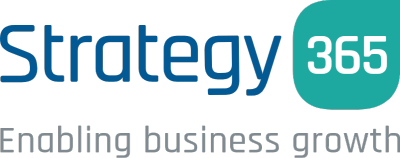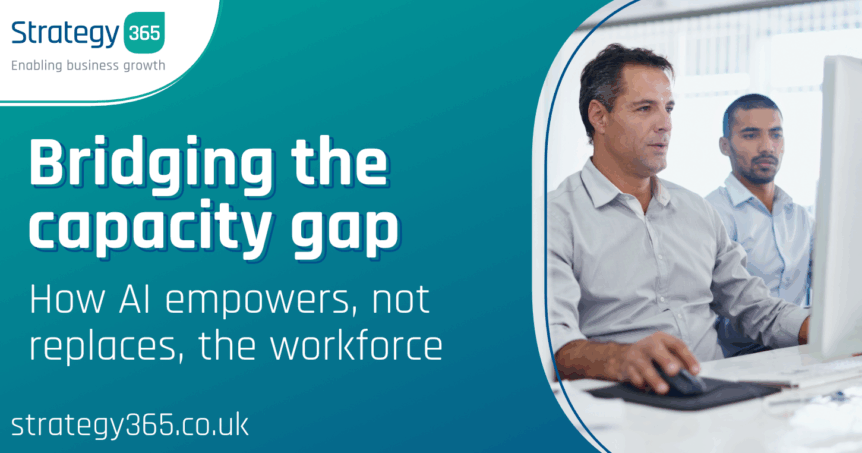Struggling with capacity gaps? Discover how Copilot can transform your workflow and give your team more time to focus where it matters.
Bridging the capacity gap: How AI empowers, not replaces, the workforce
A new era of work
The capacity gap is quickly becoming one of the biggest challenges facing modern businesses and it’s being brought into sharper focus by the rise of AI.
Every major technological revolution has reshaped the way we work. The Industrial Revolution mechanised labour, boosting productivity but introducing challenges like pollution and dangerous work conditions. The Internet Revolution connected the world, enabling remote collaboration and instant communication, yet also ushered in burnout, digital overload, and online safety concerns.
Now, we are seeing the AI Revolution, a transformation not just of tools, but of how we think and work. AI isn’t just helping us tick off tasks faster or automate mundane processes, it’s starting to take on more complex responsibilities like analysing information, making recommendations, and even generating ideas. But as this technology becomes more capable, it also highlights a familiar problem: most teams simply don’t have enough time or headspace to do the high-level creative, strategic tasks they would like to do.
That’s where the idea of the capacity gap comes in.
What is the capacity gap?
In simple terms, the capacity gap is the gap between everything a business wants to get done and what their people actually have the time, energy, or headspace to deliver. The reality is that there are only a limited number of hours in the day, and we’re surrounded by constant distractions. Staff are struggling with the sheer volume of tasks competing for attention.
According to Microsoft’s 2025 Work Trend Index, 53% of business leaders say productivity needs to go up, but 80% of employees and executives say they’re already stretched too thin, resulting in a pretty big disconnect.
The answer isn’t to work harder, it’s to work smarter using AI.
The real issue is what Microsoft calls the coordination tax; that’s the time lost to emails, meetings, and admin that eats into the hours people could be spending on meaningful work. It’s the reason why follow-ups fall through the cracks and strategic thinking gets pushed to “when we have time,” which often means never.
As Jared Spataro, Microsoft’s CMO of AI at Work, put it: “Someday we’ll look back and see this as an inflection point in the evolution of technology – a change that will profoundly impact how we think about, organise, and deploy cognitive labour.”
In other words, we’re at a turning point. AI isn’t just a shiny new tool, it has become a way to rethink how work gets done, and one of its biggest strengths is helping to close that capacity gap.
Two sides of the AI coin: Assistant and Agent
To understand how AI helps bridge the capacity gap, it’s useful to look at the two main ways it shows up in the workplace: as an assistant, and as an agent.
AI as an Assistant
This is the version most people are familiar with. Think of Microsoft 365 Copilot in Word, Excel, or Outlook. It helps you write emails, summarise meetings, draft documents, or pull together reports. It’s there to make your day-to-day tasks quicker and easier, like a digital sidekick that takes care of the admin so you can focus on the bigger picture.
For example, sometimes you might want to re-engage a client you haven’t spoken to in a while, but you can’t quite remember why the relationship fizzled out. Digging through old emails, meeting notes, and shared files can take ages, and let’s be honest, due to the time investment it’s unlikely to happen.
With Microsoft 365 Copilot, you can ask, “What happened with Client X last year?” and get a summary pulled from across your organisation’s data, that’s SharePoint, Teams, OneNote, Outlook summarised in seconds. It gives you the context you need to reach out with confidence, without spending half your morning on detective work.
Make no mistake, Microsoft 365 Copilot is a powerful tool. Ultimately it serves to help you and your team do what you already do, but faster and more efficiently.
AI as an Agent
This is where things get more interesting. AI agents, like Copilot agents, are more autonomous and they’re designed to take on specific tasks or workflows and run with them, often without needing constant input from a human.
Microsoft refers to this as the rise of ‘digital labour’. These agents can now do things like:
- Search across your organisation’s files, emails, and notes to surface relevant information
- Personalise outreach to hundreds of leads based on context and behaviour
- Research new markets or competitors and summarise key insights
They don’t just assist, they carry out set actions, and from what we’ve seen here at Strategy 365 over the last 12 months, they’re getting better at it all the time.
The key point that we all need to bear in mind is that AI isn’t replacing people, it’s giving them a head start. It’s laying the groundwork so that when a human steps in, they’re already halfway there and they can bring their own emotional intelligence, nuance, and lived experience to that piece of work.
How do AI agents plug the capacity gap?
These examples show how AI agents can take on tasks that are often left undone, not because they’re unimportant, but because no one has the time.
Sales Agent: turning trade show leads into conversations
Let’s say you’ve just come back from a busy trade show. You’ve got a spreadsheet of 300+ leads with names, emails, maybe a few notes about what each person was interested in. Traditionally, you’d send a bulk email thanking everyone for visiting your stand. It’s generic, and most people ignore it.
Now imagine an AI agent that can take that spreadsheet, understand what each person was looking at, and send a personalised follow-up. It might include relevant case studies, product info, or even answer initial questions. The agent handles the first few interactions, and only hands over to a human when the conversation becomes more complex.
This gives your sales team a way to follow up with every lead properly, without spending days writing emails or sending a generic follow up.
Analyst Agent: Making sense of messy data
You’ve got a pile of spreadsheets from different teams, each formatted slightly differently, and you need to pull together a report on sales performance. Normally, this would mean hours of manual work consisting of comparing and trying to spot trends across regions and time periods. It’s the kind of task that gets pushed down the to-do list because it’s just too fiddly.
With the Microsoft 365 Copilot Analyst agent, you can simply ask, “Compare sales data by region and quarter and highlight key trends,” and it’ll do the heavy lifting for you. Attach your files, and Analyst will consolidate the data, surface insights, and present them in a clean, visual report. Get answers fast!
Researcher Agent: From party planning to market research
If you’ve ever been given the task of planning the company’s Christmas party, you’ll know the struggle is real. A researcher agent can take your team’s location, budget, and preferences, and come back with tailored suggestions, saving hours of Googling and comparing options!
The same kind of agent can be used for much more strategic work, such as pulling together a list of key players, trends and relevant legislation for a new industry to impress a hot lead. It’s like having a junior researcher on hand, ready to give you a head start.
Understanding the capacity gap helps shift the conversation around AI from fear to practicality, it’s not about replacing people, it’s about helping them get more done.
The Microsoft Advantage
When it comes to choosing AI tools that genuinely support your team, Microsoft has a clear edge. Unlike many third-party platforms, Microsoft 365 Copilot works securely within your existing tenant, meaning your data stays protected and governed under enterprise-grade controls. That’s a big deal for businesses handling sensitive client information or working in regulated industries.
It also integrates seamlessly with the tools your team already uses, like Outlook, Teams, and SharePoint, so agents can access and act on your data without needing manual uploads or risky external connections. For small and medium-sized businesses, this means less friction, better security, and faster results.
Even the Ministry of Defence uses Microsoft’s AI infrastructure. That’s a strong vote of confidence in its reliability and compliance.
Final thoughts
AI isn’t here to take over, it’s here to help. And when you look at it through the lens of the capacity gap, it becomes clear that its real value lies in freeing up time for the work that matters most.
Whether you’re in sales, marketing, operations, or leadership, there are always tasks that get pushed aside, not because they’re unimportant, but because there’s never quite enough time. AI agents give you a way to tackle those tasks without burning out your team.
To get the most from Copilot, it’s worth speaking to one of our experts to ensure that you implement it correctly. As a Microsoft Solutions Partner, why not get in touch with one of our team today?



